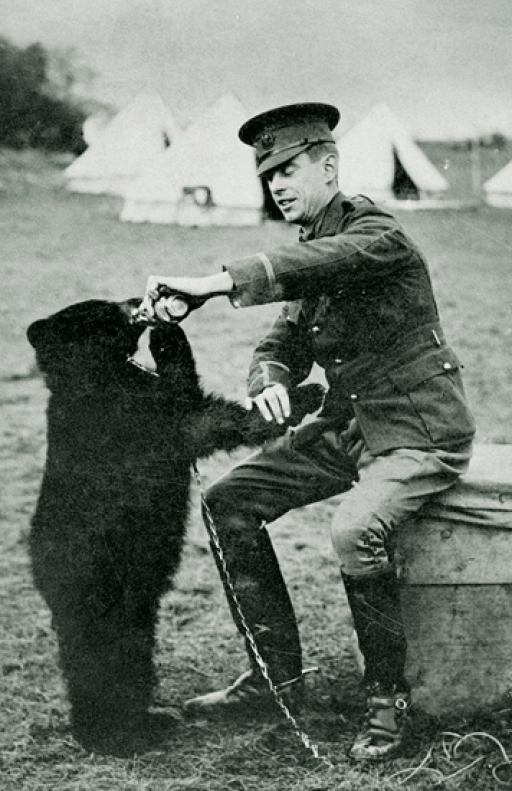Centenary News writer, Christopher Harvie, tells the story of how an act of kindness from a Canadian Lieutenant 100 years ago led to a literary legend beloved by millions around the world.
En route by rail from his home in Manitoba to the new training camp for the Canadian Expeditionary Force at Valcartier, Quebec, a young officer paid a small sum of money in an act of kindness which would help inspire an icon of children’s literature. In his diary for the 24th of August, 1914, Lieutenant Harry Colebourn wrote: “On train all day. Bought cub bear at White River. Amt. Paid, $20.00” It was at a brief stop in the small Ontario town that Colebourn, a veterinary surgeon, encountered a hunter who had killed the mother of the black bear cub.
A Life Saved and a Friend Made
With the consideration inherit to his calling, the Birmingham born doctor knew the baby bear would likely not survive without care. He snuck her onto the train and named her after his adopted home town of Winnipeg. Somewhere along the way, the name was shortened and the bear became known as “Winnie.” At Valcartier, Lt. Colebourn was assigned to the Royal Canadian Army Veterinary Corps and attached to the headquarters of 2 Brigade, 1st Canadian Division. Winnie was rarely not at Colebourn’s side. Very docile and playful, she would quickly be come 2 Brigade’s unofficial mascot.
As the Division embarked for England in October, Winnie was smuggled aboard ship, the men having grown so attached to her they risked ire rather than leave behind their favourite pet. In the months of continued training through a miserable winter on Salisbury plain, Winnie shared Colebourn’s tent, sleeping under his bed.
Winnie Stays Behind
The Brigade commander, Colonel Arthur Currie, drew the line at taking the bear to France and Colebourn had to part with Winnie, trusting her to the London Zoo. His constant companion for more than half a year, Colebourn said goodbye to the gentle bear, not knowing if he would see her again. Surprisingly, this was not a rare event she was one of at least five bears given to the Zoo by Canadians in the first year of the war. Though not alone, Winnie was the best behaved and well liked of the lot, quickly becoming a featured attraction.
Lt. Colebourn never forgot his pet, and did manage to visit her upon every leave from the front he was granted. It was his intention to take Winnie back to Canada with him when the war was over.
The Devoted Officer Returns
Promoted to Captain, twice mentioned in despatches for “untiring devotion to his duties”, nominated for a Distinguished Service Order (which was not awarded), Colebourn would gain acceptance to further his studies at the Royal College of Veterinary Surgeons, staying in England for two years after the war.
Seeing how popular she was with visitors, especially children, Colebourn donated Winnie to the London Zoo in 1919. He returned to Winnipeg and private practice in 1920.
From Beloved Pet to Literary Legend
One of the children who adored Winnie, and visited her often was Christopher Robin Milne. His father describes with tenderness the young boy’s encounter:
“So when Christopher Robin goes to the Zoo, he goes to where the Polar Bears are, and he whispers something to the third keeper from the left, and doors are unlocked, and we wander through dark passages and up steep stairs, until at last we come to the special cage, and the cage is opened, and out trots something brown and furry, and with a happy cry of “Oh, Bear!” Christopher Robin rushes into its arms.”—A.A. Milne, Introduction to Winnie the Pooh
Christopher Robin would name his teddy after her, and along with his other plush toys would be given immortality in A.A. Milne’s tales of their adventures in the Hundred Acre Wood, first printed under the title “Winnie the Pooh” in 1926 with illustrations by E.H. Shepard.
The Legacy of Man and Bear
Winnie, much loved and famous, died at London Zoo in 1934 at age twenty, considered a long life for a black bear. Retiring in 1945 after a successful career, Major Colebourn passed away in 1947.
Today, in Winnipeg and London, monuments, statues and even a postage stamp remember the man and the bear he saved who would become beloved by millions.
From November 5 to December 7, Toronto’s Ryerson University will be featuring an interdisciplinary project involving the Colebourn Family Archive put on public display for the first time. Donated by Lindsay Mattick, Colebourn’s greatgranddaughter, the Archive is comprised of photographs, letters, diaries and one of the doctor’s veterinary kits. These artefacts will be available for viewing at the University’s Student Gallery of the Ryerson Image Centre, as well as digitally accessible via a companion website to the exhibit.
